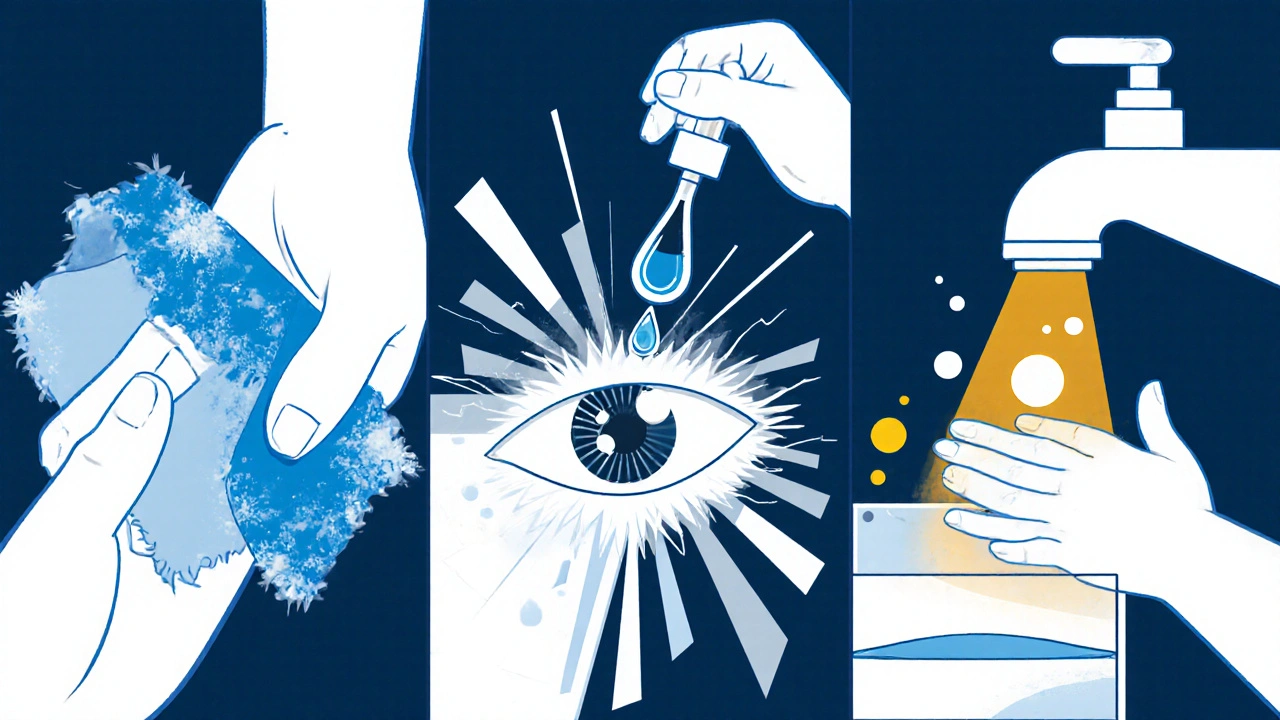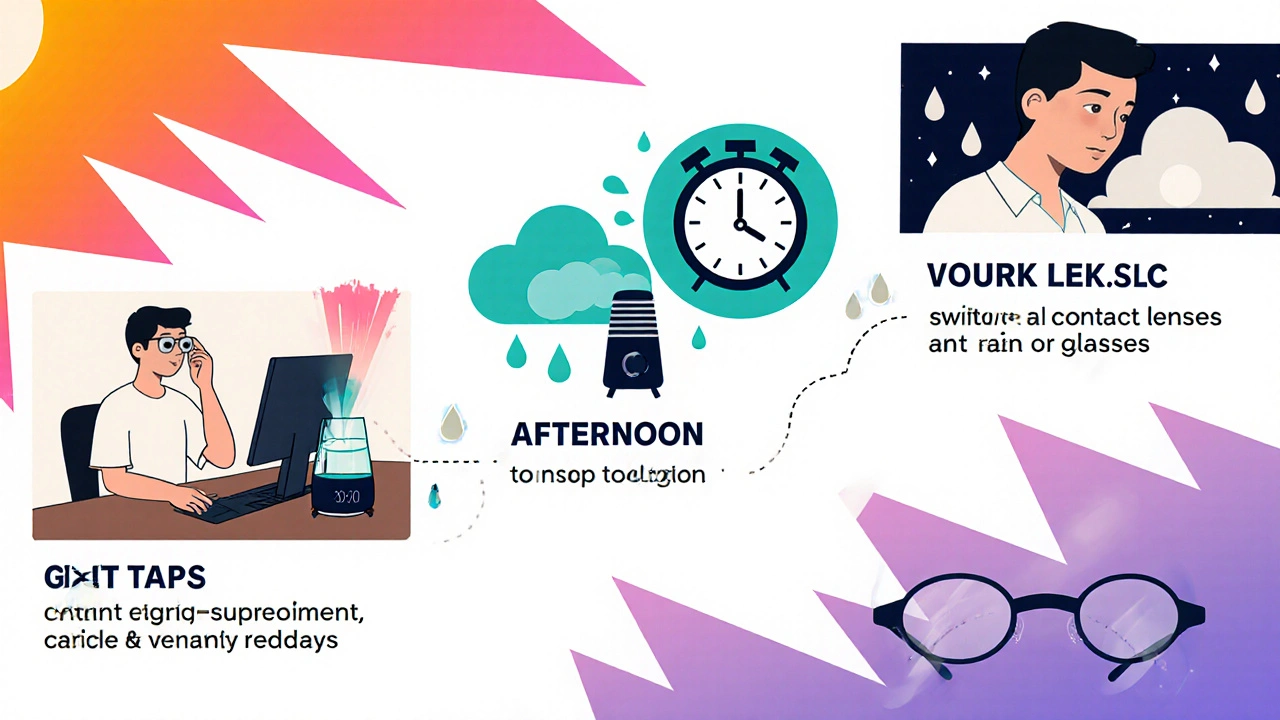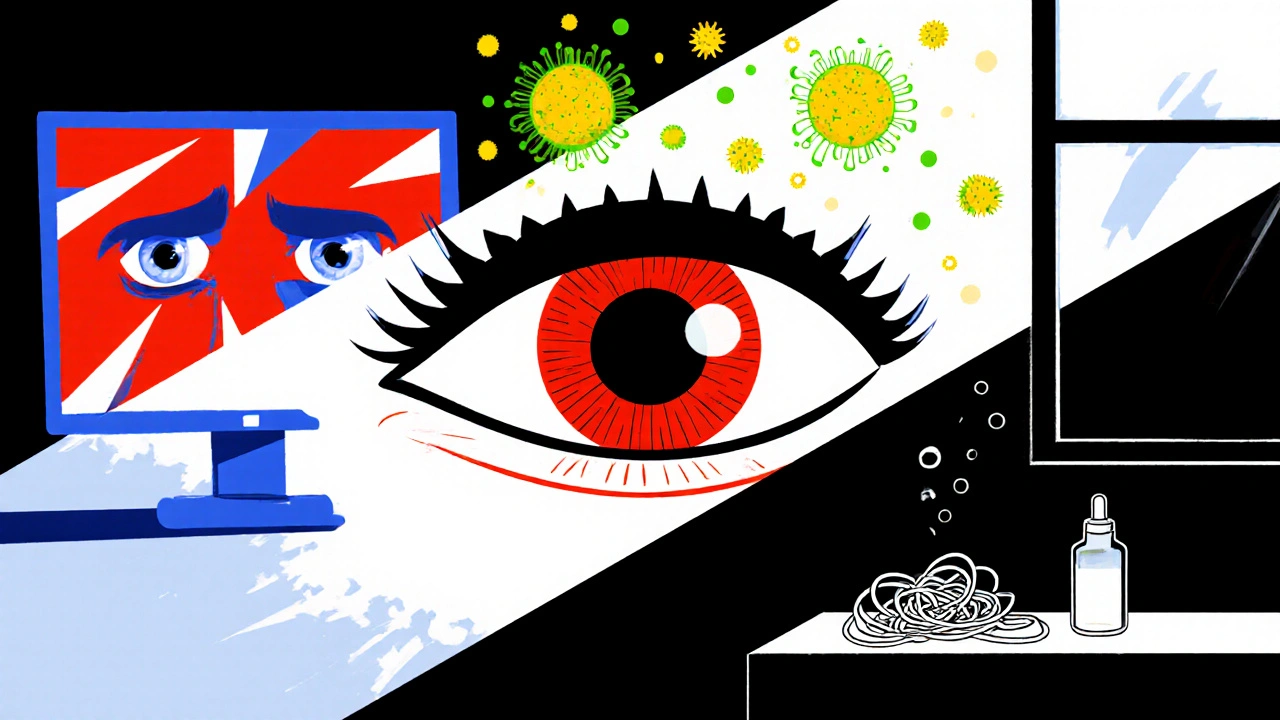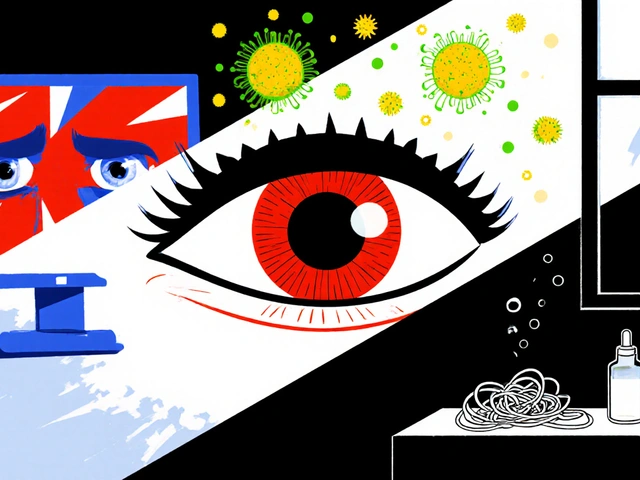20-20-20 Rule Eye Break Timer
Reduce eye strain and prevent redness with the 20-20-20 rule: Every 20 minutes, look at something 20 feet away for 20 seconds.
How to use:
1. Click Start to begin your 20-minute break cycle.
2. When the timer finishes, take a 20-second break to look at something 20 feet away.
3. Repeat throughout the day to prevent eye redness and fatigue.
When your eyes look bloodshot, it’s not just a cosmetic issue - it can signal irritation, infection, or an underlying health problem. This guide walks you through the most common triggers of eye redness and gives you practical, everyday actions to keep the whites clear and comfortable.
Quick Takeaways
- Identify and avoid the top three everyday causes: screen fatigue, allergens, and contact lens misuse.
- Use a three‑step relief routine: cool compress, lubricating drops, and proper hygiene.
- Adopt long‑term habits like the 20‑20‑20 rule, humidified air, and regular lens cleaning.
- Know the red‑flag symptoms that require a professional exam.
- Choose safe over‑the‑counter products - artificial tears before medicated drops.
What Is Eye Redness?
Eye redness is a condition where the visible portion of the eye, the sclera, or the inner lining, the conjunctiva, become inflamed and appear pink or blood‑filled. The inflammation usually results from dilated blood vessels reacting to irritants, infections, or dryness. While occasional redness is normal after a night of little sleep, persistent or painful redness warrants attention.
Top Everyday Triggers
Most people experience eye redness because of lifestyle habits. Below are the three biggest culprits and how they work.
- Digital eye strain: Staring at screens for hours reduces blink rate, leading to a thin tear film and dry spots. The eye compensates by flushing blood to the surface, creating a red appearance.
- Allergens: Pollen, pet dander, and dust mites trigger histamine release in the conjunctiva, swelling the tiny vessels.
- Contact lens misuse: Over‑wear, poor cleaning, or using lenses past their expiry can trap microbes and debris, provoking inflammation.
Understanding these triggers helps you cut them out before redness becomes chronic.
Common Medical Conditions Behind Red Eyes
Beyond everyday irritants, several medical conditions routinely produce redness. Recognizing them can speed up treatment.
- Conjunctivitis (pink eye) - an infection or allergy of the conjunctiva that results in watery, sticky discharge and bright red eyes.
- Dry Eye Syndrome - insufficient tear production or poor tear quality, leading to gritty, red eyes, especially after prolonged screen time.
- Blepharitis - inflammation of the eyelid margin that can cause crusting, itching, and redness.
- Uveitis - deeper inflammation of the uvea; often painful and requires urgent care.

Immediate Relief: The 3‑Step Routine
When you notice redness, follow this quick protocol to soothe the eyes within minutes.
- Cool compress: Soak a clean cloth in cold water, wring out excess, and place over closed eyes for 2-3 minutes. The cold constricts blood vessels, reducing the pink hue.
- Lubricating drops (Artificial Tears): Use preservative‑free artificial tears (e.g., Refresh Optive) to re‑hydrate the ocular surface. Apply one drop in each eye, wait 30 seconds, then repeat if needed.
- Hygiene check: Wash hands, avoid touching the eyes, and if you wear contacts, remove them. Clean lenses with an appropriate solution, or switch to glasses until the redness subsides.
Long‑Term Prevention Strategies
Preventing future episodes relies on adjusting habits and environment.
- 20‑20‑20 rule: Every 20 minutes, look at something 20 feet away for 20 seconds. This restores blinking and tear film balance.
- Humidify indoor air: In dry climates or heated rooms, use a humidifier set to 40‑50% relative humidity to keep eyes from drying out.
- Allergy management: Keep windows closed on high‑pollen days, use HEPA filters, and consider over‑the‑counter antihistamine eye drops (Ketotifen) during peak seasons.
- Contact lens hygiene: Replace lenses as prescribed, disinfect daily, and never reuse solution. Consider weekly disposable lenses if you’re prone to irritation.
- Nutrition for eye health: Incorporate omega‑3 fatty acids (found in fish, flaxseed) and lutein‑rich foods (spinach, kale) to support tear production.
When to Seek Professional Care
Most redness clears with home care, but certain signs mean you should book an appointment with an optometrist or ophthalmologist.
- Persistent redness lasting more than 48 hours despite treatment.
- Severe pain, light sensitivity, or blurred vision.
- Yellow or green discharge - potential bacterial infection.
- Sudden vision loss or floaters.
Early diagnosis of conditions like uveitis or acute glaucoma can be vision‑saving.

Safe Over‑The‑Counter Products
Not every eye drop is suitable for every cause. Here’s a quick guide.
| Product Type | Active Ingredient | Best For |
|---|---|---|
| Artificial Tears | Polyethylene Glycol | Dry eye, screen fatigue |
| Antihistamine Drops | Ketotifen | Allergy‑related redness |
| Lubricating Ointment | Petrolatum | Night‑time dryness |
| Antibiotic Drops | Polytrim | Bacterial conjunctivitis (prescribed) |
| Decongestant Drops | Naphazoline | Short‑term redness relief (avoid >3 days) |
Reserve decongestant drops for occasional use only; overuse can cause rebound redness.
Putting It All Together: A Sample Day Plan
To illustrate how the tips fit into a routine, imagine a typical work‑from‑home day.
- Morning: Apply preservative‑free artificial tears after waking.
- 8:00 am - 12:00 pm: Follow the 20‑20‑20 rule while on video calls; keep a humidifier on low.
- Lunch break: Use a cool compress for 3 minutes if eyes feel gritty.
- Afternoon: If you’re a contact‑lens wearer, store lenses in fresh solution and replace them as scheduled.
- Evening: Switch to glasses, use omega‑3 supplements, and apply a lubricating ointment before bed.
By the end of the day, you’ll likely notice fewer blood vessels flaring and a calmer, clearer look.
Frequently Asked Questions
Can eye redness be caused by stress?
Stress itself doesn’t directly inflame the eye, but it can lead to poor sleep, increased screen time, and eye‑rubbing, all of which trigger redness. Managing stress helps reduce those secondary factors.
Are over‑the‑counter antihistamine drops safe for children?
Most pediatric formulations are safe for kids over two years, but dosage should follow the label or a doctor’s advice. For infants, consult a pediatrician before any eye medication.
How long should I wear a cool compress?
Two to three minutes is enough to constrict surface vessels without causing discomfort. Repeat after a short break if needed.
Is it okay to use makeup after my eyes look red?
If the redness is due to an infection, avoid eye makeup until it clears to prevent spreading germs. If it’s dry‑eye related, use hypoallergenic, non‑comedogenic products.
What home remedy can I use if I have no eye drops?
A sterile saline solution (store‑bought or homemade with boiled water and sea salt) can rinse irritants. Follow with a cool compress for soothing.
By understanding what drives eye redness and applying these practical steps, you’ll keep your eyes bright, comfortable, and ready for whatever the day throws at you.








Caroline Keller October 19, 2025
I cant stand people who ignore basic eye care it feels like a betrayal of their own health the 20-20-20 rule is not optional it's essential when you stare at screens for hours you are practically begging for redness and irritation we need to treat our eyes with the respect they deserve stop the endless scrolling and actually blink more often the world will be brighter if you stop painting your whites red
dennis turcios October 27, 2025
The guide hits the main points but it glosses over the fact that not all artificial tears are equal some contain preservatives that can worsen dryness for contact lens wearers a quick look at the ingredient list can save you from that pitfall also, consider rotating between drops if one stops being effective.
Madhav Dasari November 3, 2025
Hey buddy, you’re on the right track! Remember to set a timer for the 20‑20‑20 rule; it’s a game‑changer for screen fatigue. Keep a humidifier nearby especially in winter, and don’t forget omega‑3 supplements – they really help tear production. If you follow these steps consistently, those red eyes will become a thing of the past.
Jameson The Owl November 11, 2025
The truth about eye redness is buried beneath layers of mainstream health advice that the powers that be don’t want you to see it. Most people are fed a steady diet of over‑the‑counter drops that act like a bandage on a bleeding wound rather than treating the root cause. The real culprits are often the very devices that power our modern lives. Smartphones, laptops, tablets – every glowing screen emits blue light that disrupts the natural blink reflex. When we stare at these screens for hours the tear film evaporates faster than it can be replenished. The government and big tech companies benefit from us staying glued to our screens because it drives advertising revenue and data collection. They also fund research that downplays the long‑term ocular damage while promoting cheap lubricants that keep us buying repeat products. The 20‑20‑20 rule sounds simple but it’s rarely enforced, and the interfaces are designed to keep us scrolling without pause. Humidity levels in office buildings are deliberately kept low to reduce energy costs, which only exacerbates dry eye symptoms. Contact lens manufacturers lobby against stricter cleaning standards, allowing sub‑par solutions to stay on the market. Allergy seasons are manipulated through climate engineering, increasing pollen counts and making our eyes more susceptible to inflammation. If you truly want to protect your vision you must scrutinize the sources of your eye care products and demand transparent ingredient disclosures. Choose preservative‑free tears, avoid decongestant drops unless absolutely necessary, and consider blue‑light filtering glasses that are independently tested. In the end, the battle for clear eyes is not just about hygiene; it’s a fight against a system that profits from our discomfort.
Sarah Unrath November 18, 2025
i saw u had a lot of tips but i think u forgot 2 mention that sometimes dusty rooms can make your eyes red too its easy just wipe the surfaces and use a fan
Nicole Boyle November 26, 2025
From a biomechanical perspective the ocular surface behaves like a dynamic tear film equilibrium, where disruption of the lipid layer leads to increased osmolarity and subsequent hyperemia. Incorporating a micro‑environmental control protocol, such as ambient RH optimization and blue‑light spectral filtration, can significantly modulate the homeostatic set point. Moreover, leveraging anti‑inflammatory cytokine inhibitors in topical formulations offers a prophylactic avenue for chronic conjunctival vasodilation.
Latasha Becker December 3, 2025
While the article advocates artificial tears as first‑line therapy, studies show that overreliance on lubricants may mask underlying meibomian gland dysfunction. A more evidence‑based approach would prioritize lid hygiene and thermal pulsation before introducing any drop regimen.
parth gajjar December 11, 2025
Ah the lament of modern eyes, a tragic symphony of overstimulation and neglect. One must rise above the pedestrian advice and embrace a holistic renaissance of ocular care, wherein the soul of vision is nourished by contemplation and the purest of essences. Only then shall the crimson veil lift.
Maridel Frey December 18, 2025
Thank you for the encouraging tone. Your reminder to integrate omega‑3s and maintain consistent break intervals aligns well with evidence‑based recommendations. Consistency indeed transforms temporary relief into lasting ocular health.